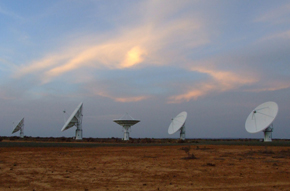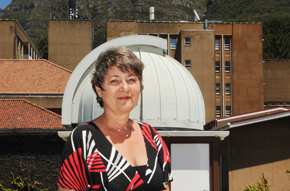SKA decision will expand UCT's astronomy reach even further
28 May 2012 | Story by NewsroomUCT scholars enthusiastically welcomed the decision by the SKA Site Advisory Committee (SSAC) and its associates to assign a portion of the international Square Kilometre Array (SKA) of radio telescopes to South Africa.
 |
 |
| Reaching for the heavens: South Africa's MeerKAT array will be a major component of the SKA project, and will - until the SKA goes online - serve as one of the largest radio telescopes in the world. (Photo courtesy of the SKA.) | Looking ahead: "Instrumentation, computer sciences, programming, mathematics, computer hardware - all these sectors will benefit from having SKA here," says UCT's Prof Renée Kraan-Korteweg. |
The majority of SKA dishes in phase 1 of the €1.5 billion project will be built in South Africa combined with MeerKAT, aka the Karoo Array Telescope, the South African array currently under construction in the Karoo region. Further SKA dishes will be added to the Australian Square Kilometre Array Pathfinder (ASKAP).
All the dishes and the mid frequency aperture arrays for phase II of the SKA will be built in Southern Africa, while the low frequency aperture array antennas for phase I and II will be built in Australia and New Zealand.
Professor Danie Visser, the deputy vice-chancellor at UCT responsible for research, said: "It is a red-letter day in the development of science in South Africa. This is one of the biggest scientific research ventures ever undertaken and it confirms that developing nations can also be a part of solving the big questions of our day. It will bring scientists from all over the world to South Africa (and to UCT in particular) and thus greatly enhance not only South Africa's but also UCT's international research collaboration. SKA also brings important opportunities for job creation and the development of the country as a whole."
The university's Department of Astronomy is the only dedicated, independent university department focused on astronomy in South Africa, with strong ties and joint positions with the South African Astronomical Observatory and increasing interaction with the SKA SA project office. It has partnerships with other astronomy groups in South Africa, and through the National Astrophysics and Space Science Programme; and with other universities and agencies in Africa, Australia, Europe and North America. Until the SKA is completed, the 10-year MeerKAT project offers one of the largest radio telescopes in the world for research.
For the next decade it will remain the most sensitive radio telescope in the Southern Hemisphere. The completed MeerKAT array will comprise 64 dishes of 13.5m in diameter; its precursor, KAT-7 with seven dishes, is already functional. Four out of 10 key science projects assigned to the MeerKAT array of radio telescopes in the Karoo are already led or co-led by researchers at UCT.
Professor Renée Kraan-Korteweg, the head of the astronomy department at UCT, said: "There is a shortage of good astronomers, in particular radio astronomers in South Africa - especially for the facilities we expect to be built or expanded, which will offer opportunities for recruiting at staff and post-doctorate levels. UCT's goal is to train future leaders in radio astronomy for these kinds of opportunities."
UCT is the only South African university to include a major in astrophysics in its undergraduate programme. It is attracting a steadily increasing number of students. Kraan-Korteweg noted that 75% of undergraduates in the astrophysics programme at UCT are black South Africans.
She said other branches of science and technology would also strongly benefit from the parts of SKA that are assigned to South Africa: "Instrumentation, computer sciences, programming, mathematics, computer hardware - all these sectors will benefit from having SKA here," she said. "Eighty percent of the engineers at the SA SKA office are South African."
 This work is licensed under a Creative Commons Attribution-NoDerivatives 4.0 International License.
This work is licensed under a Creative Commons Attribution-NoDerivatives 4.0 International License.
Please view the republishing articles page for more information.










